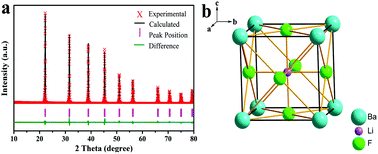The crystal structure and upconversion properties of Yb3+, Er3+/Ho3+ codoped BaLiF3 microcrystals with different morphologies
Abstract
A series of x mol% Yb3+, 1 mol% Ho3+/1 mol% Er3+ (0 ≤ x ≤ 25) codoped BaLiF3 microcrystals with different cubic morphologies and sizes (1.52 μm–3.83 μm) were synthesized by a facile surfactant-assisted hydrothermal-microemulsion approach for the first time. The crystalline structure of BaLiF3 was established via the Rietveld refinement result of the powder X-ray diffraction (XRD) data. In addition, the growth process of cubic BaLiF3 crystals and the influence of different synthesis conditions on the morphology were studied by scanning electron microscopy (SEM) and transmission electron microscopy (TEM). Moreover, in this paper we first investigated the upconversion luminescence (UCL) properties of new Er3+/Ho3+, Yb3+-codoped BaLiF3 microcrystals under 980 nm excitation. The characteristic emission of Er3+ and Ho3+ was obtained, respectively. The blue emission in BaLiF3:Yb3+, Ho3+ which was comparatively more difficult to discover was also observed and explained by the energy level diagram. It is worthwhile to point out that BaLiF3:Yb3+, Er3+ practically showed pure red upconversion (UC) emission under excitation at 980 nm and the reasons behind this behavior are presented and discussed.


 Please wait while we load your content...
Please wait while we load your content...